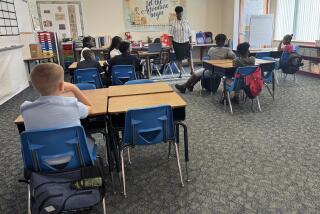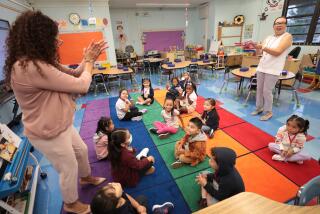Fewer Pupils Create More Worries
- Share via
Over the last seven years, nearly 400 students have left the public school rosters in Santa Barbara. Enrollment in this wealthy, Spanish-tiled coastal haven has dropped as steadily as home prices have risen.
It is a trend expected to continue as the median home price pushes past $1 million.
It is also a trend that increasingly appears to be occurring across California.
Public schools circling downtown Los Angeles are losing students as their neighborhoods gentrify. A similar shift is underway in the Bay Area, Sacramento and Los Angeles, and Orange and Ventura counties.
Statewide, public school enrollment was down slightly this year, for the first time in nearly a quarter of a century. And though officials aren’t quite sure of all the reasons behind the drop, they are sure that the cost of housing is one of them.
In Santa Barbara, school administrators worry about lost revenue, because funding is tied to enrollment.
Already, administrators said, the decline has cost the district millions annually. Now, having made small, less-painful cuts, they are considering larger steps, such as selling off vacant property or building housing to sell to teachers at below-market value.
Building the houses, they say, would help recruit teachers, who otherwise might not be able to afford the area, and the school system would bring in some revenue from the sales.
Another option is to start closing schools, a move that is always unpopular, said Jan Zettel, the Santa Barbara School Districts’ assistant superintendent of secondary education.
“We don’t think we will have to close a school in the next year,” he said, “but beyond that, yes, it’s entirely possible.”
In the 2005-06 school year, statewide school enrollment dropped for the first time in 24 years. There were 6,313,103 pupils enrolled, a decline of about 10,000 from the previous year, according to state Department of Education records.
State officials aren’t sure whether the trend will continue. Projections had called for continued student growth through at least 2010, said Donna Rothenbaum, a spokeswoman in the education department’s demographics unit. She said several factors could contribute, including local job losses, changes in migration patterns and lower fertility rates. But a major trigger, analysts say, is the state’s sky-high housing market.
Student losses appear to be highest in high-cost coastal regions, especially around Los Angeles and the Bay Area. Housing prices in those regions are among the highest in the state, analysts note.
At ABC Unified, based in Cerritos, enrollment has dropped by 1,000 students over the last five years, officials said.
In Orange County, Fountain Valley schools are losing 60 to 100 students a year. Similar declines have been recorded in Ojai and Oak Park school districts in Ventura County.
In Sacramento, San Juan Unified School District is closing schools because of decreased enrollment, Rothenbaum said.
“It wasn’t that long ago that we couldn’t build schools fast enough,” said Hans Johnson, a demographer at the San Francisco-based Public Policy Institute of California. “Now we’ve switched to which schools to close.”
Santa Barbara’s housing market is so out of reach for young families, Johnson said, that when couples there decide to buy a home, they move inland. The pattern is common throughout California, he said.
“There are still areas of enrollment growth, but they are in places like San Bernardino and Riverside, and in the cities east of the Bay Area,” Johnson said.
Housing in Santa Barbara was already more expensive than other areas when the boom in home prices began five years ago. In June, the median price passed $1 million.
That has squeezed out teachers, police officers, firefighters and other middle-wage earners, creating a two-tiered economy, said William Fulton, president of Solimar Research Group, a Ventura-based planning and development research firm.
“You have rich people who don’t have kids and poor people living two or three families to a house,” Fulton said.
In Santa Barbara Unified’s 13 elementary schools, 70% of students are Latino and 25% are white. Citywide, population estimates are nearly reversed: 58% of residents are white and 35% are Latino.
Most of the remaining students are from immigrant families and struggle just to read and write in English, Zettel said.
The evidence of white flight out of the city’s schools has made the challenge more difficult, educators said. Once begun, white flight can be a difficult cycle to break, Zettel said. La Cumbre Junior High School has lost hundred of students in recent years, he said.
“We started to see people looking around, getting worried,” he said. “And if you’re wealthy, you have a lot of education options.”
The school board will study several ways to use two vacant parcels next month. But already there is opposition from neighborhood groups that fear construction of hundreds of units beyond what current zoning densities allow.
Details won’t be released until the school board meets Aug. 8, officials said. But the study is expected to spell out what it would take to build housing for teachers on the properties. They are zoned for 115 units, but nearby residents fear the district could seek to rezone for as many as 400 homes and condos.
If built for staff, the homes would be sold at below-market rates. Teachers would be required to sell the homes after retirement and share the profits with the school district.
Another option would be for the district to sell the land to developers. A 2005 appraisal estimated that the properties could bring $23.5 million total.
Gary Earle, president of Coalition for Sensible Planning, said residents aren’t opposed to the idea of affordable housing for teachers. But they don’t want hundreds of units on a lot zoned for 75 homes, he said.
“They have to be a good neighbor and build something that is consistent with what’s already here,” he said of a 23-acre property near tract housing in Goleta. “Why should one neighborhood be ruined to solve their financial problems?”
Other districts have explored alternatives to selling off surplus property. The Oak Park Unified School District in 2004 passed a $197-per-parcel tax to raise $1 million annually, said Assistant Supt. Cliff Moore.
Oak Park officials expect the current 3,800-student population to shrink by half in about a decade. Build-out and high home prices constrict the district’s ability to attract new students, Moore said.
If the parcel tax is not renewed after it expires in three years, Oak Park could be facing school closures, he said.
“With our small district, we don’t have economies of scale,” he said. “We could be looking at some pretty severe cuts in the next five to seven years.”
In the ABC Unified School District, most of the student losses have occurred at the elementary level. Economic pressure has made it difficult for young families in Cerritos, Artesia, Hawaiian Gardens and Lakewood to buy homes, officials said.
Though the district has not closed schools, it has reduced class size in kindergarten through third grade and ninth grade, with a resulting loss in state reimbursements, said Kathy Frazier, the district’s director of schools.
The district is trying to attract more working families this fall by offering part- to full-day kindergarten at all of its elementary schools and simplifying the registration process, Frazier said.
The challenge, educators say, is figuring out how to maintain a quality education as revenue shrinks. Without supplementary dollars, popular programs, such as music, art and sports, could be eliminated.
Moore said he fears a future of haves and have-nots, where schools located in well-to-do neighborhoods will be able to hang on to their extras through parcel taxes and educational foundations, while those in lower-income areas will suffer.
“Schools could be in trouble,” he said. “There could be a widening gap and that’s pretty scary.”
More to Read
Sign up for Essential California
The most important California stories and recommendations in your inbox every morning.
You may occasionally receive promotional content from the Los Angeles Times.











